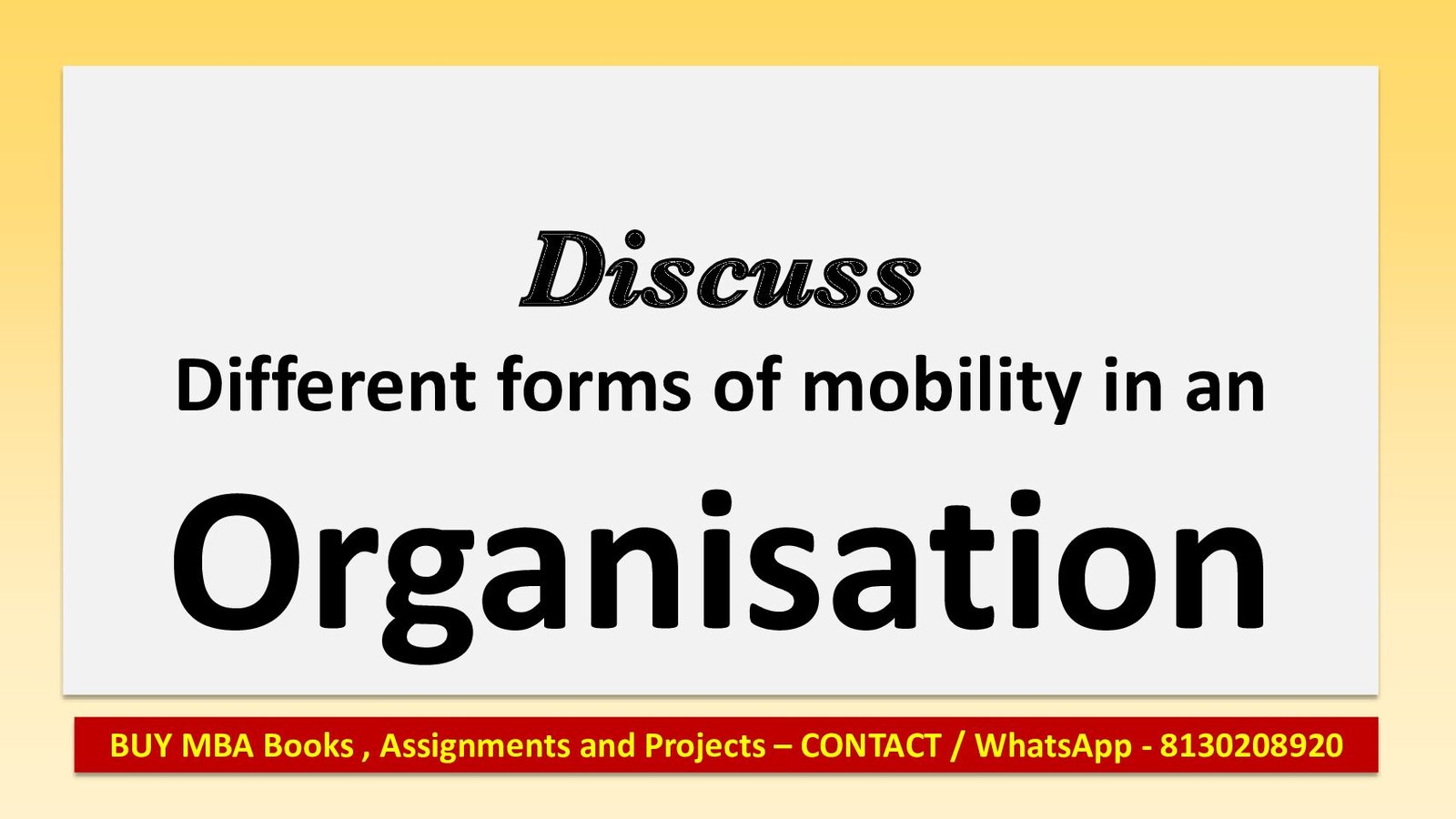Discuss different forms of mobility in an organisation
Discuss different forms of mobility in an organisation, In the dynamic landscape of modern business, organizational mobility has become a crucial aspect for ensuring flexibility, adaptability, and overall efficiency. The term “organizational mobility” encompasses a wide array of practices and technologies that enable employees and processes to move seamlessly within an organization. Discuss different forms of mobility in an organisation
1. Physical Mobility:
a. Office Layouts and Flexible Workspaces:
One of the traditional yet impactful forms of mobility within an organization is the design of office spaces. The shift from conventional cubicles to open-floor plans or activity-based workspaces promotes physical mobility among employees. This design encourages collaboration, facilitates communication, and allows for easy interaction between team members.
b. Hot Desking and Flextime:
Hot desking is a practice where employees do not have assigned desks but instead choose from available workspaces. This not only optimizes space utilization but also promotes physical mobility as employees move around the office. Similarly, flextime allows employees to choose their working hours, providing them with the freedom to structure their workday according to personal preferences, thus enhancing physical mobility.
READ MORE – MMPC – 002 Solved Assignment 2023-24
2. Digital Mobility:
a. Remote Work and Virtual Collaboration:
The advent of digital technologies has revolutionized the concept of mobility within organizations. Remote work, made possible by high-speed internet and collaboration tools, allows employees to work from anywhere, transcending geographical boundaries. Virtual collaboration platforms facilitate real-time communication, file sharing, and project management, ensuring that teams remain connected regardless of their physical locations.
b. Mobile Applications and BYOD Policies:
The proliferation of smartphones has given rise to mobile applications that enable employees to access work-related information and perform tasks on the go. Bring Your Own Device (BYOD) policies further enhance digital mobility by allowing employees to use their personal devices for work purposes. This not only increases flexibility but also contributes to a more mobile and agile work environment.
3. Knowledge Mobility:
a. Cross-Training and Skill Development:
To create a workforce that is adaptable and multifaceted, organizations invest in cross-training programs. These initiatives expose employees to various roles and responsibilities, equipping them with diverse skills. This not only enhances their professional development but also ensures knowledge mobility within the organization, as employees become proficient in multiple areas.
b. Knowledge Sharing Platforms:
Implementing knowledge sharing platforms, both digital and physical, is crucial for promoting the transfer of expertise within an organization. These platforms can include intranet portals, collaborative wikis, and regular knowledge-sharing sessions. By encouraging employees to share their insights and experiences, organizations foster a culture of continuous learning and knowledge mobility.
4. Operational Mobility:
a. Agile Methodology and Project Teams:
Agile methodology, widely adopted in project management, emphasizes iterative development and collaboration among cross-functional teams. This approach promotes operational mobility by allowing teams to adapt quickly to changing requirements and collaborate seamlessly. Project teams, composed of members with diverse skills, further contribute to operational mobility by leveraging collective expertise to achieve project goals.
b. Decentralized Decision-Making:
Empowering employees at various levels with decision-making authority contributes to operational mobility. When decision-making is decentralized, employees feel a sense of ownership and responsibility. This not only expedites the decision-making process but also ensures that decisions align with the organization’s goals. Decentralization fosters agility and responsiveness, key components of operational mobility.
5. Cultural Mobility:
a. Diversity and Inclusion Initiatives:
Cultural mobility within an organization involves creating an inclusive environment that values diversity. Diversity and inclusion initiatives aim to build a workforce with varied perspectives, backgrounds, and experiences. Such cultural mobility fosters innovation, as employees bring unique insights to the table, leading to more creative problem-solving and decision-making processes.
b. Employee Rotation Programs:
Employee rotation programs enable individuals to work in different departments or roles within the organization. This not only broadens their skill set but also promotes cultural mobility by exposing employees to different organizational cultures and ways of working. Through such programs, employees gain a holistic understanding of the organization, enhancing their ability to collaborate effectively.
BUY NOW HANDWRITTEN ASSIGNMENT
Conclusion:
Discuss different forms of mobility in an organisation, In conclusion, organizational mobility takes various forms, each contributing to the overall adaptability and efficiency of an organization. The synergy between physical, digital, knowledge, operational, and cultural mobility creates a dynamic environment where employees can collaborate seamlessly, respond to changes rapidly, and contribute to innovation. Embracing diverse forms of mobility is not just a trend but a strategic imperative for organizations seeking sustained success in today’s fast-paced business landscape. As technology continues to evolve and workplace dynamics undergo transformation, organizations that prioritize mobility will be better positioned to navigate the challenges and capitalize on the opportunities that lie ahead.

